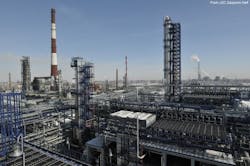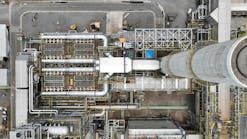Gazprom Neft advances Omsk refinery modernization projects
JSC Gazprom Neft has completed installation of major equipment related to the reconstruction and modernization of the primary crude oil distillation unit at its 21.4 million-tonne/year Omsk refinery in Western Siberia, Russia.
A series of fractionating columns have been installed at the newly reconstructed AT-9 distillation unit, with precommissioning activities for the equipment now under way, Gazprom Neft said.
A range of additional installation and construction work associated with rebuilding AT-9 is ongoing, including the pouring of concrete foundations for a 260 tonnes/hr closed-flare unit, which will be the first ever to be installed at any Siberian refinery, according to the company.
Construction activities for a transformer substation and control room, as well as installation of 30 km of process pipelines, also are under way at the refinery, Gazprom Neft said.
In addition to improving energy efficiency and reducing operating costs for the refinery, modernization of AT-9 will increase the plant’s output by 12% to 5 million tpy to provide high-quality feedstock for integrated isomerisation, gasoline reforming, and deep-conversion units, allowing the Omsk refinery to increase its overall production of diesel fuels and high-octane gasoline, the company said.
The newly reconstructed distillation unit also will allow the refinery to integrate its electrical desalting and oil dehydration processes, as well as gasoline stabilization, into a single production cycle, according to Oleg Belyavsky, the refinery’s general director.
Upon completion of the unit’s reconstruction at yearend, the refinery will be able to eliminate a range of additional obsolete processing units, Belyavsky added, without identifying the units involved.
Ongoing modernization plans
Late in 2014, Gazprom Neft switched to the exclusive production of Euro 5-standard diesel fuels at the Omsk refinery, with the switchover enabling the refinery to boost its diesel output to 6.3 million tpy, a twofold increase compared with Omsk’s diesel production in 2013 (OGJ Online, Feb. 12, 2015).
The refinery’s improved performance in 2014 stems from Gazprom Neft’s phased program to modernize and upgrade its Russian refineries to improve processing capacities, oil conversion rates, energy efficiency, production quality, and environmental impacts by 2020 (OGJ Online, Dec. 2, 2013).
As part of first-stage modernization work at Omsk, the company commissioned a catalytic-cracking and diesel hydrotreatment complex (OGJ Online, Aug. 2, 2011).
The second phase of the modernization program, which aims to improve the overall yield of light-end refined products, currently is under way and includes the following projects:
• Reconstruction of a catalytic cracking unit.
• Reconstruction of an alkylation unit, which will increase the unit’s production capacity.
• Construction of a grassroots methyl tertiary butyl ether plant (OGJ Online, Dec. 3, 2014).
In December 2013, the company also let a contract to CB&I, Houston, for front-end engineering and design services for multiple process units at Omsk, including a 2 million-tpy hydrocracker unit licensed by Chevron Lummus Global, as well as hydrogen, sulfur, and other associated units (OGJ Online, Dec. 9, 2013).
Contact Robert Brelsford at [email protected].

